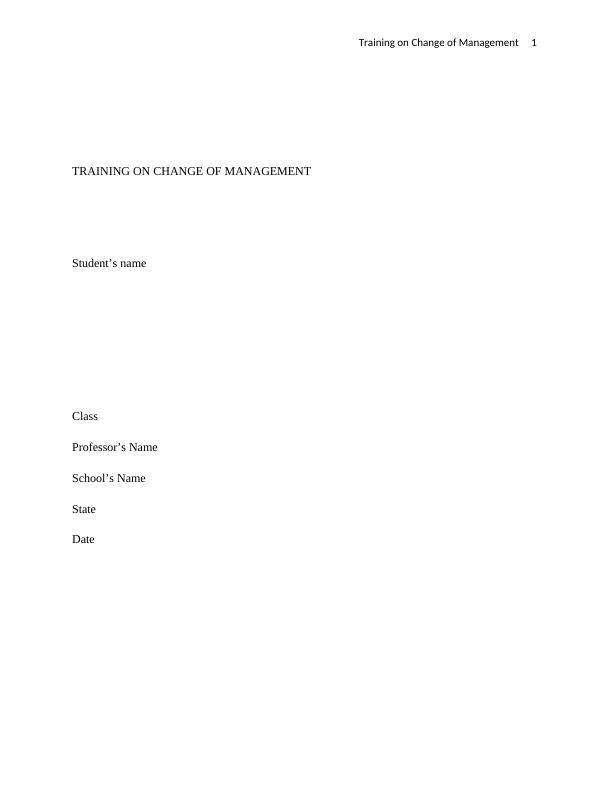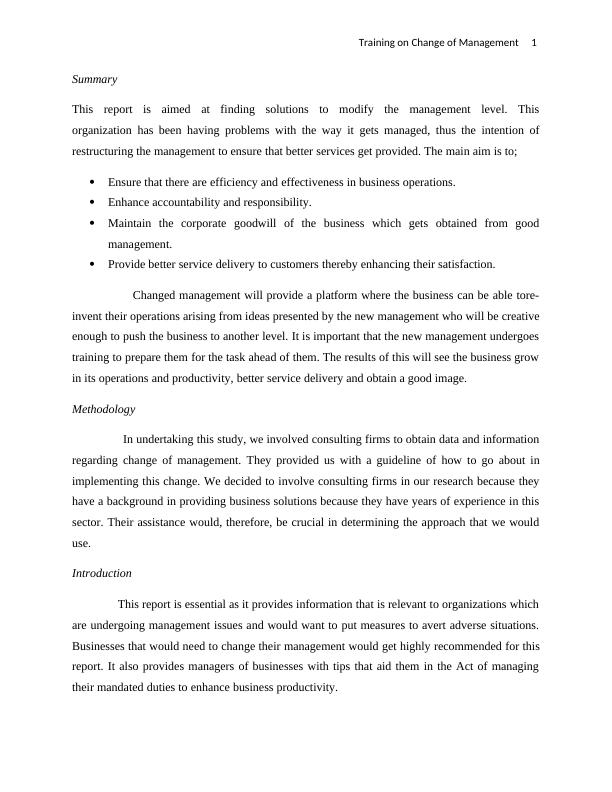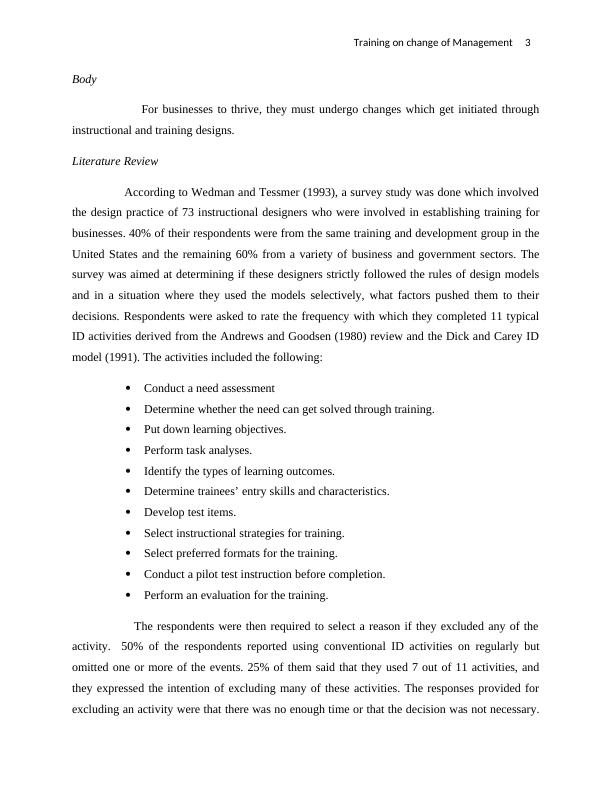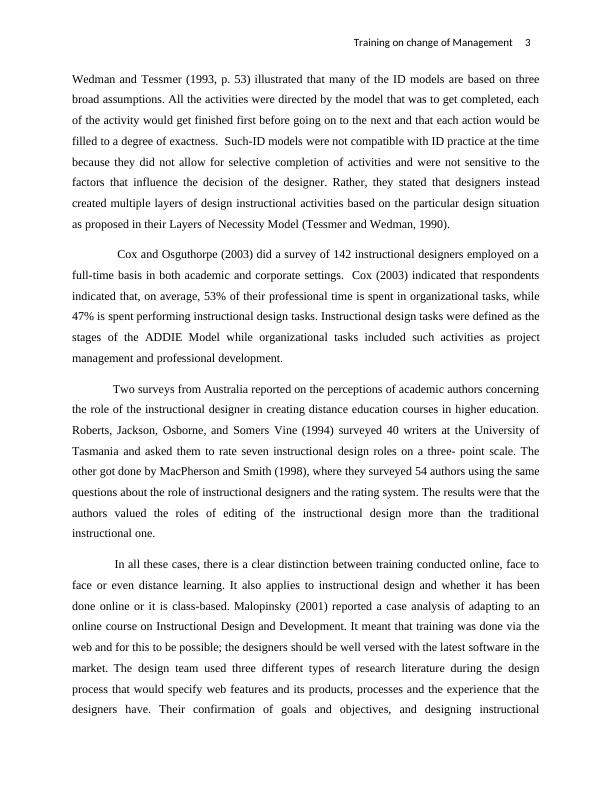Report On The Solutions To Change Management
11 Pages3193 Words63 Views
Added on 2020-02-05
Report On The Solutions To Change Management
Added on 2020-02-05
ShareRelated Documents
Training on Change of Management 1TRAINING ON CHANGE OF MANAGEMENTStudent’s nameClassProfessor’s NameSchool’s NameStateDate

Training on Change of Management 1SummaryThis report is aimed at finding solutions to modify the management level. Thisorganization has been having problems with the way it gets managed, thus the intention ofrestructuring the management to ensure that better services get provided. The main aim is to;Ensure that there are efficiency and effectiveness in business operations.Enhance accountability and responsibility.Maintain the corporate goodwill of the business which gets obtained from goodmanagement.Provide better service delivery to customers thereby enhancing their satisfaction. Changed management will provide a platform where the business can be able tore-invent their operations arising from ideas presented by the new management who will be creativeenough to push the business to another level. It is important that the new management undergoestraining to prepare them for the task ahead of them. The results of this will see the business growin its operations and productivity, better service delivery and obtain a good image.Methodology In undertaking this study, we involved consulting firms to obtain data and informationregarding change of management. They provided us with a guideline of how to go about inimplementing this change. We decided to involve consulting firms in our research because theyhave a background in providing business solutions because they have years of experience in thissector. Their assistance would, therefore, be crucial in determining the approach that we woulduse.Introduction This report is essential as it provides information that is relevant to organizations whichare undergoing management issues and would want to put measures to avert adverse situations.Businesses that would need to change their management would get highly recommended for thisreport. It also provides managers of businesses with tips that aid them in the Act of managingtheir mandated duties to enhance business productivity.

Training on change of Management 3Body For businesses to thrive, they must undergo changes which get initiated throughinstructional and training designs.Literature Review According to Wedman and Tessmer (1993), a survey study was done which involvedthe design practice of 73 instructional designers who were involved in establishing training forbusinesses. 40% of their respondents were from the same training and development group in theUnited States and the remaining 60% from a variety of business and government sectors. Thesurvey was aimed at determining if these designers strictly followed the rules of design modelsand in a situation where they used the models selectively, what factors pushed them to theirdecisions. Respondents were asked to rate the frequency with which they completed 11 typicalID activities derived from the Andrews and Goodsen (1980) review and the Dick and Carey IDmodel (1991). The activities included the following: Conduct a need assessmentDetermine whether the need can get solved through training. Put down learning objectives. Perform task analyses. Identify the types of learning outcomes. Determine trainees’ entry skills and characteristics. Develop test items. Select instructional strategies for training. Select preferred formats for the training. Conduct a pilot test instruction before completion. Perform an evaluation for the training. The respondents were then required to select a reason if they excluded any of theactivity. 50% of the respondents reported using conventional ID activities on regularly butomitted one or more of the events. 25% of them said that they used 7 out of 11 activities, andthey expressed the intention of excluding many of these activities. The responses provided forexcluding an activity were that there was no enough time or that the decision was not necessary.

Training on change of Management 3Wedman and Tessmer (1993, p. 53) illustrated that many of the ID models are based on threebroad assumptions. All the activities were directed by the model that was to get completed, eachof the activity would get finished first before going on to the next and that each action would befilled to a degree of exactness. Such-ID models were not compatible with ID practice at the timebecause they did not allow for selective completion of activities and were not sensitive to thefactors that influence the decision of the designer. Rather, they stated that designers insteadcreated multiple layers of design instructional activities based on the particular design situationas proposed in their Layers of Necessity Model (Tessmer and Wedman, 1990). Cox and Osguthorpe (2003) did a survey of 142 instructional designers employed on afull-time basis in both academic and corporate settings. Cox (2003) indicated that respondentsindicated that, on average, 53% of their professional time is spent in organizational tasks, while47% is spent performing instructional design tasks. Instructional design tasks were defined as thestages of the ADDIE Model while organizational tasks included such activities as projectmanagement and professional development. Two surveys from Australia reported on the perceptions of academic authors concerningthe role of the instructional designer in creating distance education courses in higher education.Roberts, Jackson, Osborne, and Somers Vine (1994) surveyed 40 writers at the University ofTasmania and asked them to rate seven instructional design roles on a three- point scale. Theother got done by MacPherson and Smith (1998), where they surveyed 54 authors using the samequestions about the role of instructional designers and the rating system. The results were that theauthors valued the roles of editing of the instructional design more than the traditionalinstructional one. In all these cases, there is a clear distinction between training conducted online, face toface or even distance learning. It also applies to instructional design and whether it has beendone online or it is class-based.Malopinsky (2001) reported a case analysis of adapting to anonline course on Instructional Design and Development. It meant that training was done via theweb and for this to be possible; the designers should be well versed with the latest software in themarket.The design team used three different types of research literature during the designprocess that would specify web features and its products, processes and the experience that thedesigners have. Their confirmation of goals and objectives, and designing instructional

End of preview
Want to access all the pages? Upload your documents or become a member.
Related Documents
Requirement Elicitation and Specification for Campus Common System (CCS)lg...
|10
|1552
|93
Business Research Methodology: Reportlg...
|6
|1275
|136
Ensure a Safe Workplace for a Work Arealg...
|8
|1539
|75
Business Planning Reviewlg...
|13
|1051
|65
Zoomba: Food Delivery Mobile Applg...
|19
|5277
|30
Review of Organizational Learning and Developmentlg...
|10
|622
|32
